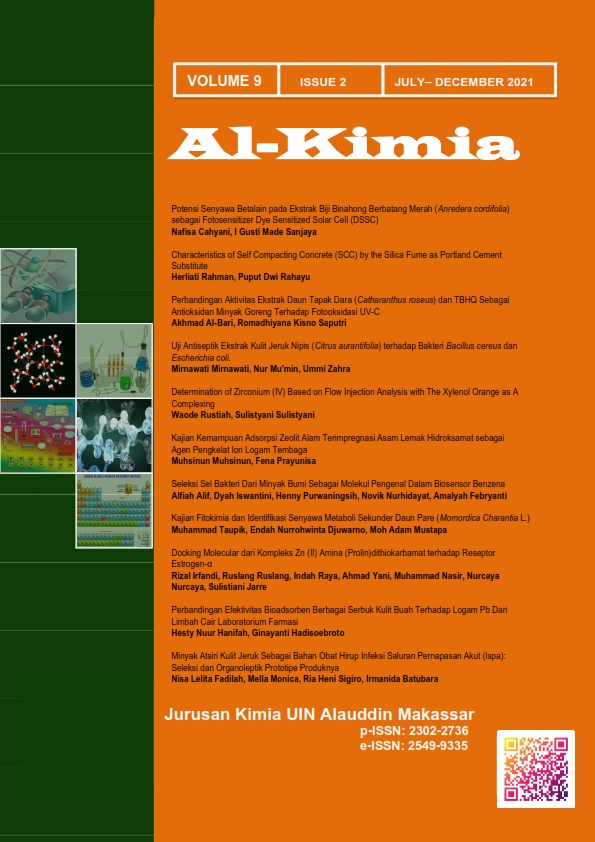Characteristics of Self Compacting Concrete (SCC) by the Silica Fume as Portland Cement Substitute
Abstract
Self-compacting concrete (SCC) is a type of concrete that can flow by itself and can self-compact without using a compactor such as a vibrator. This study aims to observe the effect of cement substitution with silica fume on the compressive strength of concrete. The researchers expect a compressive strength of Self Compacting Concrete up to 500 kg/cm2, although silica fume substituted some portland cement. In order to reduce water use while maintaining the slump flow value of 60±2 cm, a superplasticizer was added at the fixed composition of 1.2% (w/w). The experimental design of silica fume as a cement substitute with a variation of 0%, 5%, 10%, and 15% (w/w). The concrete compressive strength test is carried out under the ASTM C234 standard, while the slump flow value refers to the ASTM C494 standard and the British Standard 5075. Although there was no compressive strength of 500 kg/m2 for all types of cement obtained, it shows that the highest compressive strength of SCC concrete was in the type of OPC cement at 28 days of age.Downloads
References
Adi, Y. M., Mousavi, S. d., ami, F. R., Danes, A., & Sarand, N. I. (2015). The Effect of Silica Fume on the Properties of Self-Compacted Lightweight Concrete. Curr. World Environ., 381-388.
Amhudo, R. L., Putu, R. I., & Tavio, T. (2018). Comparison of Compressive and Tensile Strengths of Dry-Cast Concrete with Ordinary Portland and Portland Pozzolana Cements. Civil Engineering Journal, 4(8), 1760-1771.
ASTM. (2015). Annual Book of ASTM Standard Construction. Amarican.
Benaichaa, M., Alaoui, A. H., & Jalbaud, O. (2019). Dosage effect of superplasticizer on self-compacting concrete: correlation between rheology and strength. J Mater Res Technol, 2063–2069.
Caijun, Wu, S., Lv, K., & Wu, L. (2015). A review on mixture design methods for self-compacting concrete. Construction and Building Materials, 387-398.
Chouhan, P., Jamle, S., & Verma, M. (2017). Effect of Silica Fume on Strength Parameters of Concrete As A Partial. IJSART, 968-972.
Herliati, Asyha, D. P., & Nulhakim, L. (2020, Desember). Optimasi Clinker Ratio Pada Portland Pozzoland Cement (Ppc) Dengan Pozzoland Fly Ash. Jurnal Migasian, 11-17.
Ketab, A. K., & Nahhab, A. H. (2020). The Performance of Self-Consolidating Concretes with Lightweight Aggregates. TEST, 14920 – 14932.
Panjehpour, M., Ali, A. A., & Demirboga, R. (2011). A Review For Characterization of Silica Fume And its Effects On Concrete Properties. International Journal of Sustainable Construction Engineering & Technology, 1-7.
Schutter, G. D., Bartos, P. J., Domone, P., & Gibbs, J. (2008). Self-Compacting Concrete. Scotland, UK: CRC Press LLC,.
Shyam, A., Anwar, A., & Ahmad, S. A. (2017). A Literature Review on Study of Silica fume as Partial Replacement of Cement in Concrete. International Journal of Advanced Engineering, Management and Science (IJAEMS), 250-253.
Singh, H., & Bansal, S. (2015). Effect of Silica Fume on The Strength of Cement Mortar. IJRET: International Journal of Research in Engineering and Technology, 623-627.
Singh, P., Khan, M. A., & Kumar, A. (2016). The Effect on Concrete by Partial Replacement of Cement by Silica Fume: A Review. International Research Journal of Engineering and Technology (IRJET), 118-121.
SNI-03-2834. (2000). Tata Cara Pembuatan Rencana Campuran Beton Normal. Jakarta: Badan Standardisasi Nasional.
SNI-2049. (2015). Semen Portland. Jakarta: Badan Standardisasi Nasional.
Authors who publish with this journal agree to the following terms:
1) Authors retain copyright and grant the journal right of first publication with the work simultaneously licensed under a Creative Commons Attribution License that allows others to share the work with an acknowledgement of the work's authorship and initial publication in this journal.
2) Authors are able to enter into separate, additional contractual arrangements for the non-exclusive distribution of the journal's published version of the work (e.g., post it to an institutional repository or publish it in a book), with an acknowledgement of its initial publication in this journal.
3)Authors are permitted and encouraged to post their work online (e.g., in institutional repositories or on their website) prior to and during the submission process, as it can lead to productive exchanges, as well as earlier and greater citation of published work (See The Effect of Open Access).


